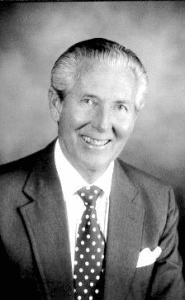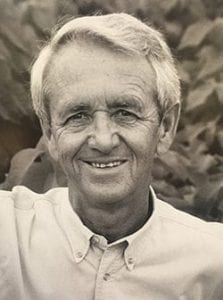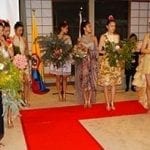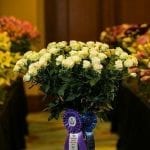
Ole Brodersen Nissen, AAF
During the holidays, two floral industry members who pioneered new ideas and products — and received the industry’s highest honor, induction into the Society of American Florists’ Floriculture Hall of Fame — passed away, leaving behind legacies of service and innovation.
Ole Brodersen Nissen, AAF, died on Dec. 21, after a life “filled with love, honor and hard work.”
“Dad set the bar high for all us with his strong commitment to family, and the floral industry,” wrote Nissen’s children, Karen, Peter and Eric, in Nissen’s obituary. “He loved his family and friends and was an example to us all until his last breath.”
Nissen founded Sunshine State Carnations in 1960. The flower production farms consist of about 70 acres in Martin County, Florida, and has been family-owned and operated ever since.
A carnation grower at the start of his career, Nissen introduced two popular varieties, ‘Danebrog’ and ‘Le Reve Salmon Sim’. Later, he helped introduce the “European look” of floral design in the U.S., growing and promoting cut flowers that were at the time unusual but have since become design staples and customer favorites, including gerberas, delphinium, snapdragons, oriental and Asiatic lilies, larkspur and more.
Throughout his career, Nissen took a holistic view of his work and the industry at large. Thinking beyond the immediate scope of his business, for instance, he designed a shipping carton that allowed cut flowers to be shipped upright in water at affordable prices, to the benefit of wholesalers, retailers and the end consumer.
His ability to stay on the leading edge of the floral industry, combined with his willingness to help others set Nissen apart, said former SAF president Terril Nell, Ph.D, AAF, the research coordinator for the American Floral Endowment and a professor emeritus at the University of Florida.
“Ole provided a visionary approach to flower production as a grower for over 50 years,” Nell said. “He promoted and supported flower research. He served the industry on many industry boards. He was totally committed to his family. And, he was always thinking of and caring for others first.”
In 2000, Nissen was inducted into SAF’s Floriculture Hall of Fame. He was also the recipient of the association’s first Golden Bouquet Award (renamed the Paul Ecke, Jr. Award in 2002), which is presented annually to a person in recognition of exemplary devotion to profession, industry and community.
Nissen was the co-founder and past president of the Florida Ornamental Growers Association, now known as the Florida Nursery, Growers and Landscape Association, and a past chairman of the American Floral Endowment. He served on the board of directors of the Florist Mutual Insurance Company (today Hortica Insurance & Employee Benefits), and on SAF’s board of directors, growers council, and former research committee. He also was chairman of the decoration committee for the inauguration of President John F. Kennedy.
Nissen was preceded in death by his beloved wife, Eleanor, and his son Christian. He was the proud grandfather of Chris, Brody, Will and Ellie Nissen.

Franz Fruehwirth
Franz Fruehwirth, the longtime chief breeder of the Ecke Ranch in Encinitas, California, died on Dec. 28, 2015.
Fruehwirth, a native of Hungary, immigrated to the United States from Germany in 1960 with his wife, Lilo, and their daughter, Monika. He was 27 and did not speak English, according to the San Diego Tribune. He worked at a tailor’s shop until Paul Ecke Jr., a customer at the shop, hired Lilo as a housekeeper and nanny and offered Fruehwirth a job caring for his plants. That was in 1962, at a time when the ranch was converting from field-grown plants to greenhouses.
“Very quickly it became obvious that he was intelligent and creative, and Dad and Grandpa began promoting him,” Paul Ecke III told the Tribune, in 1999. “He was instrumental in figuring out how to grow the poinsettias inside.”
Poinsettias in the early 1960s were fragile and tender plants with light green foliage, flexible stems and short life spans. By 1968, however, Fruehwirth had developed the first marketable long-lasting variety (C-1), and in 1985 he set a new industry standard with the first hardy dark-green leafed variety called ‘Lilo.’ Six years later, he premiered the ‘Freedom’ variety, which combined long-lasting quality with dark green leaves and vibrant dark red bracts. That variety continues to dominate poinsettia production in the United States.
In 1998, Fruehwirth’s persistence led to another breeding breakthrough which transformed Ecke’s unknown ‘Flaming Sphere’ into today’s popular ‘Winter Rose.’ Besides its success as a potted plant, ‘Winter Rose’ brought Ecke poinsettias back to the cut flower market. (Read more about this history and sale of the Ecke Ranch.)
Fruehwirth also helped revolutionize commercial growing techniques, perfecting ways to ship poinsettia cuttings to Ecke customers around the world. Over the years, he interacted with university professors and USDA staff, playing a vital role as he bridged gaps that can exist among industry, government and research.
For his many contributions, Fruehwirth received a number of prestigious honors, including induction into SAF’s Hall of Fame, in 1999, and the Luther Burbank Award from the American Horticultural Society, in 2003. (Read his Floriculture Hall of Fame acceptance speech.
Until Fruehwirth started breeding, almost all the poinsettias in the world had been mutations, said Dr. Marc Cathey, who’s now deceased but was a president emeritus of the American Horticultural Society and among those who wrote letters recommending Fruehwirth for induction into the Floriculture Hall of Fame. As Cathy told the San Diego Tribune, “He is unique because he has no scientific training to do what he does, yet he has beat all the big boys in the world.”
After his retirement, in September 2000, Fruehwirth tended his vegetable garden and avocado trees, while keeping up to date with industry trends.



